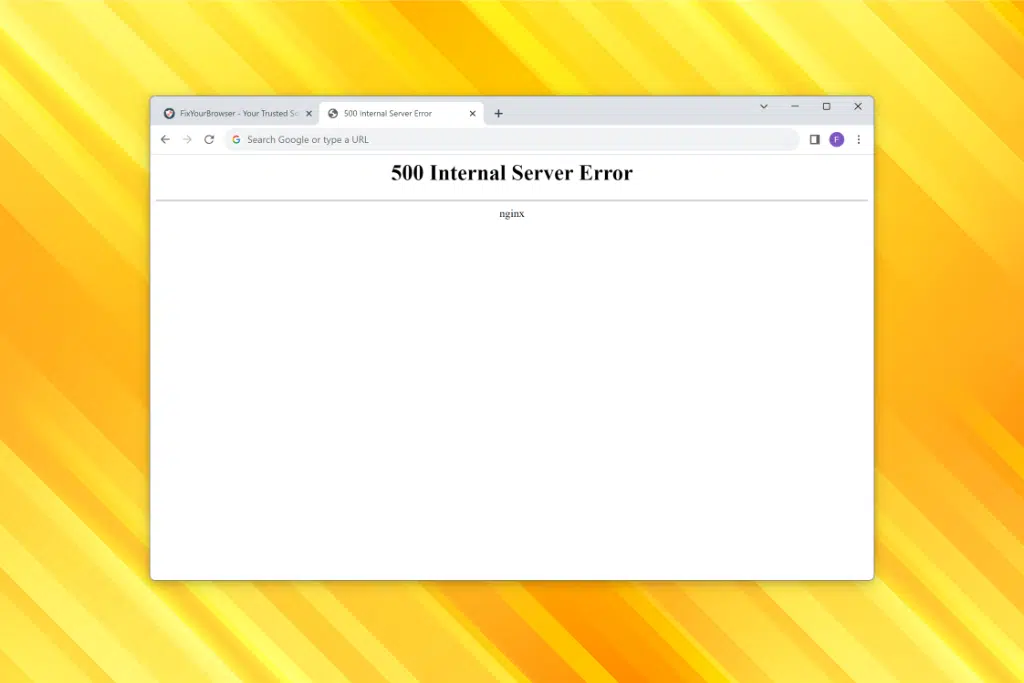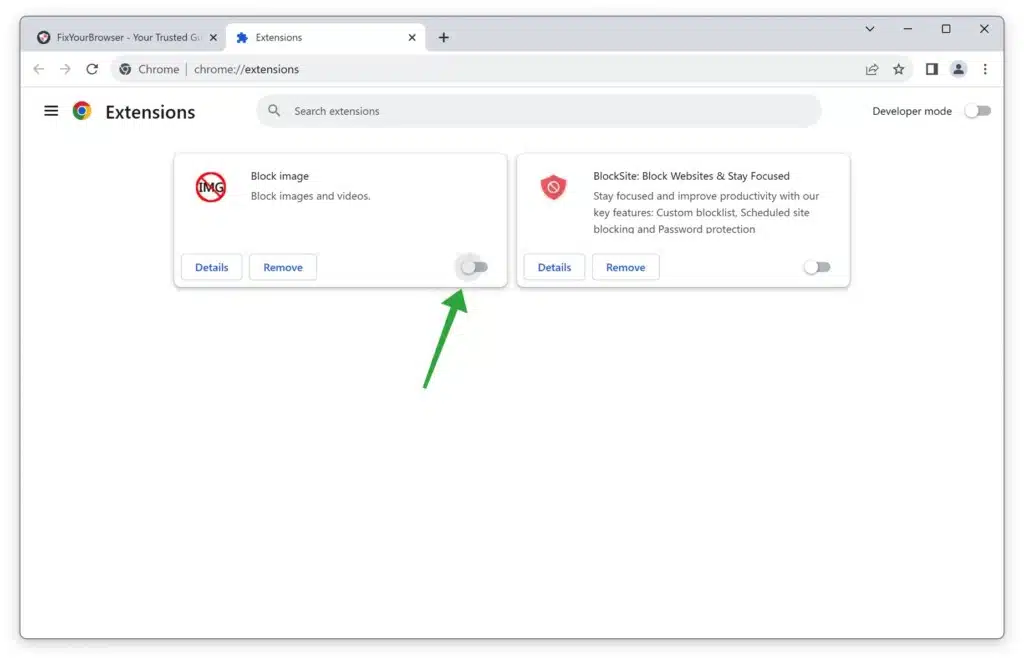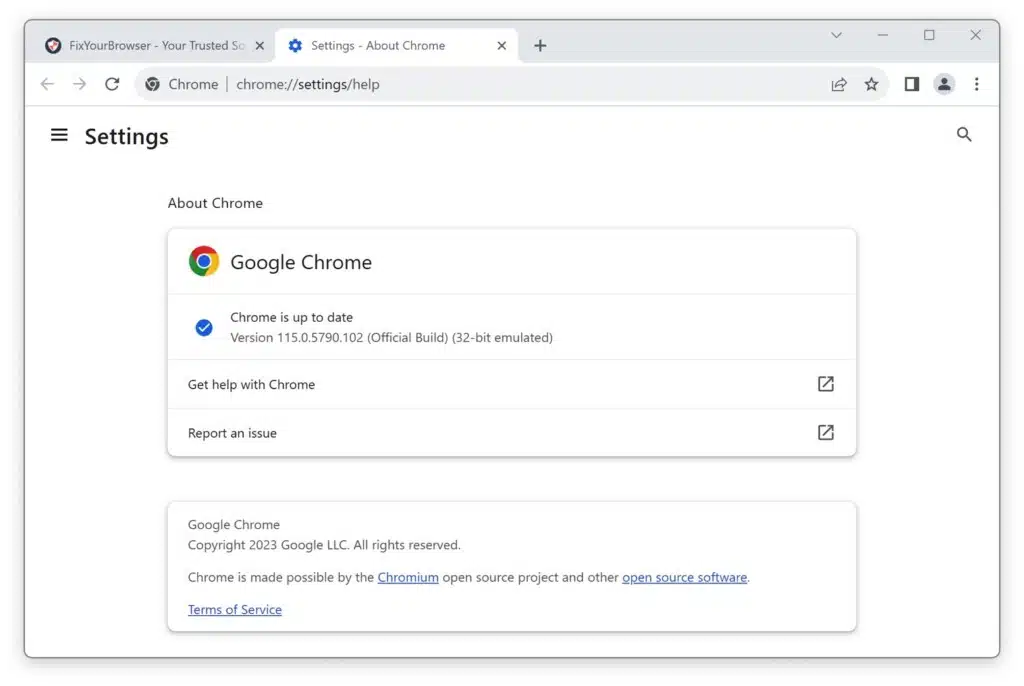Encountering a 500 Internal Server Error while using Google Chrome can be quite frustrating. It often leaves us wondering how we can resolve the problem. In this guide I will provide you with step by step instructions to fix this error and restore your browsing experience. I’ll cover everything from identifying the cause, to troubleshooting methods.
Please follow the steps outlined in the article. Before that allow me to assist you in comprehending what exactly the 500 internal server error means.
Understanding the 500 Internal Server Error
The 500 Internal Server Error is an HTTP status code that indicates something has gone wrong on the server’s end, preventing it from fulfilling the request made by the client. Unlike other HTTP status codes specific to certain errors, the 500 Internal Server Error is a generic error message that doesn’t provide much information about the underlying problem.
Common Causes of the Error
There are several potential causes for the 500 Internal Server Error, and pinpointing the exact cause can be challenging. However, some common culprits include:
- Server misconfigurations: Misconfigured server settings can lead to the 500 Internal Server Error. This could include issues with file permissions, incorrect server directives, or problems with the server’s software or hardware.
- Script or code errors: If there are errors in the scripts or code running on the server, it can trigger the 500 Internal Server Error. This could be due to syntax errors, missing files, or incompatible code versions.
- Resource limitations: Sometimes, the server may be overwhelmed with requests or lack the necessary resources to process them. This can result in the 500 Internal Server Error as the server struggles to handle the load.
Resolving the 500 Internal Server Error is crucial for website owners and users. This error can negatively impact website owners’ online presence, leading to a loss of traffic, potential customers, and revenue. It can also damage their reputation and credibility.
For users, encountering the 500 Internal Server Error can be frustrating and may discourage them from revisiting the website. It can disrupt their browsing experience and prevent them from accessing the necessary information or services.
How to Fix 500 Internal Server Error in Google Chrome
Clear Browser Cache and Cookies
To ensure your browsing is smooth, it’s essential to clear the cache and cookies on your web browser. These temporary files can build up over time. Cause problems like slow page loading, outdated content, or even error messages. In this article, I’ll guide you through the steps to clear cache and cookies in Google Chrome – one of the most widely used web browsers.
Clearing cache and cookies in Google Chrome is a process that can be done in just a few easy steps.
Follow the instructions to ensure a clean browsing experience;
- Open Google Chrome on your computer.
- Click on the three dots in the top-right corner of the browser window to open the menu.
- From the dropdown menu, select “Settings.”
- Scroll down and click on “Privacy and security” in the left-hand sidebar.
- Under the “Privacy and Security” section, click “Clear browsing data.”
- In the popup window, you will see several options. Ensure the checkboxes next to “Cookies and other site data” and “Cached images and files” are selected.
- Optionally, you can also clear other browsing data, such as browsing and download history.
- Select the time range for which you want to clear the data. If you want to clear everything, choose “All time.”
- Click on the “Clear data” button to initiate the process.
- Wait for Google Chrome to clear the cache and cookies. This may take a few moments, depending on the data being cleared.
- Once the process is complete, you will see a confirmation message.
You have successfully cleared the cache and cookies in Google Chrome by following these steps. This will help improve your browsing experience and ensure you consistently access the latest version of websites.
Reload the Page after Clearing the Cache and Cookies
After clearing the cache and cookies, it’s important to reload the page to see if the changes take effect. Sometimes, outdated files may still be stored in your browser’s cache, causing issues even after clearing the cache. Reloading the page will force the browser to fetch the latest version of the website from the server.
To reload the page in Google Chrome, click the circular arrow icon in the address bar or press the “F5” key on your keyboard. This will refresh the page and load the latest content, ensuring you are not encountering any errors or outdated information.
Disable Extensions in Google Chrome
If you’re experiencing issues while browsing the web with Google Chrome, one or more of your browser extensions or plugins may be causing the problem. Disabling these extensions and plugins can help troubleshoot and resolve various issues, including slow page loading, crashes, and compatibility problems.
Here’s how you can do it:
- Launch Google Chrome on your computer.
- Click on the three-dot menu icon in the top-right corner of the browser window.
- From the dropdown menu, hover your mouse over “Extensions” and click “Manage Extensions.”
- You’ll be redirected to the “Extensions” page, where you can see a list of all the extensions installed in your browser.
- To disable an extension, toggle the switch next to it to the off position.
- Once disabled, the extension will be grayed out, indicating no longer active.
- Repeat this process for any other extensions that you want to disable.
- After disabling the extensions, close and reopen Google Chrome to apply the changes.
By temporarily disabling extensions, you can determine if they are causing issues with your browsing experience. If the problem is resolved after disabling a specific extension, you may consider uninstalling or updating it to ensure compatibility with the latest version of Google Chrome.
Verifying Network Connectivity
Having a stable internet connection is crucial for a seamless browsing experience. However, sometimes we encounter issues with our internet connection, which can be frustrating. This article will explore how to check and troubleshoot internet connection problems to ensure a smooth online experience.
Before troubleshooting specific internet connection issues, verifying if your device is correctly connected to the network is essential.
Here’s a step-by-step guide to help you check your network connectivity:
- Check physical connections: Ensure all cables, such as Ethernet or phone line connections, are securely plugged in. If using a wireless connection, ensure your device is connected to the correct Wi-Fi network.
- Restart your router/modem: Sometimes, network issues can be resolved by simply restarting your router or modem. Unplug the power cord, wait a few seconds, and then plug it back in. Give it a few minutes to restart, and then check if your internet connection is restored.
- Test other devices: If multiple devices are connected to the same network, check if the issue is isolated to a specific device or affecting all devices. This can help narrow down the problem and determine if it’s related to your device or the network itself.
- Contact your internet service provider (ISP): If you’ve followed the steps above and still can’t establish a connection, there may be an issue with your ISP. Contact their customer support for further assistance and check for known outages in your area.
Deactivate VPN temporary
If you are using a VPN (Virtual Private Network), it may be causing the err_too_many_redirects error. Try disconnecting from the VPN and see if the error is resolved. If you need a VPN for other purposes, try connecting to a different server or contact your VPN service provider for assistance.
Check server-side
If you’ve verified that your network connectivity is not the issue, it’s time to troubleshoot specific internet connection problems. One common issue users encounter is the “500 Internal Server Error” in Google Chrome. This error typically occurs when there is an issue with the server hosting the website you’re trying to access.
To troubleshoot and resolve this error, here are some steps you can take:
- Reload the page: Sometimes, the 500 Internal Server Error is temporary and can be fixed by simply reloading the page. Press the reload button or use the keyboard shortcut (Ctrl + R or Command + R) to refresh the page and see if the error persists.
- Try a different browser: If the 500 Internal Server Error persists in Google Chrome, try accessing the website using a different browser. This can help determine if the issue is specific to Chrome or a broader problem with the website or server.
- Contact website administrator: If you’ve followed the steps above and the error persists, the issue may lie with the website itself. Contact the website administrator or support team and provide them with details about the error, including the URL and any error messages you’re seeing. They will be able to investigate further and provide a resolution.
Update the Google Chrome browser
Updating Google Chrome to the latest version is a simple process that can be done in a few easy steps. Follow the instructions below to ensure that your browser is up-to-date:
- Launch the Google Chrome browser on your computer by clicking on the Chrome icon in your taskbar or desktop.
- Once Chrome opens, click the three vertical dots at the browser window’s top-right corner. This will open a drop-down menu.
- Navigate to the “Help” section: In the drop-down menu, hover over the “Help” option. This will expand a secondary menu.
- Click on the “About Google Chrome” option from the secondary menu. This will open a new tab displaying information about your current version of Chrome.
- Chrome automatically checks for updates on the “About Google Chrome” tab. If an update is available, it will begin downloading and installing automatically. If no update is available, you will see a message indicating that Chrome is up-to-date.
- Once the update is complete, you will be prompted to relaunch Chrome. Click the “Relaunch” button to restart the browser with the latest version.
- After relaunching Chrome, you can confirm that the update was successful by repeating steps 2 to 4. The “About Google Chrome” tab should display the updated version number.
Regularly updating Chrome improves your browsing experience and safeguards your online security. Stay up-to-date and enjoy all the benefits of the latest version of Google Chrome.
Contact the Website Administrator
If you encounter a 500 Internal Server Error while using Google Chrome, the first step is to contact the website administrator. This error is typically caused by issues on the server side, meaning there is little you can do as an end-user to fix it. By contacting the website administrator, you can inform them about the error and provide any relevant details, such as the specific page or action that triggered the error. The website administrator will then be able to investigate the issue further and work towards resolving it.
Report the Error to the Webmaster
Apart from reaching out to the website administrator, you also have the option to notify the webmaster about the error. The webmaster is responsible for maintaining and overseeing aspects of the website, including dealing with server-related problems. By reporting the error to the webmaster you provide information that aids them in identifying and resolving the issue. When reporting the error, include specifics such as the error message, the URL of the page where it occurred, and any steps you took before encountering it. This information will assist the webmaster in troubleshooting and addressing the problem.
Here are a few suggestions you can offer to help guide them;
- Check the server logs for the webserver: Most servers will log all errors, so the first step should be to check the server’s error log. The logs can provide specific information about what part of your code is causing the error.
- Check file permissions: Incorrect file permissions can cause a 500 error. Ensure that your permissions are set correctly for both files and directories.
- Check .htaccess file: If you’re running an Apache server, a misconfigured .htaccess file might be the cause. Check for any syntax errors or unsupported directives.
- Increase PHP memory limit: Sometimes, the error is due to PHP running out of memory.
It’s important to note that you have limited control over server-side issues as an end-user. While there are troubleshooting steps you can take on your end, such as clearing your browser cache or disabling browser extensions, these measures may not always resolve a 500 Internal Server Error. In such cases, reaching out to the website administrator and reporting the error to the webmaster are your best courses of action.
Reset Google Chrome Settings to Default
When you encounter errors or issues while using your web browser, such as Google Chrome, one practical troubleshooting step is to reset the browser settings. This can help resolve various problems, including slow performance, frequent crashes, or unexpected behavior. This section will explore how to reset Google Chrome settings to their default state and discuss the appropriate situations for resetting browser settings.
Resetting Google Chrome settings to their default state is a straightforward process that can be done in just a few steps. Follow the instructions below to perform a reset:
- Open Google Chrome on your computer.
- Click on the three-dot menu icon in the browser window’s top-right corner.
- From the drop-down menu, select “Settings.”
- On the left sidebar, click on “Reset settings.”
- Click on the “Restore settings to their original defaults” link.
A dialog box will appear, asking for confirmation to reset Chrome settings. Remember that resetting will remove your browsing history, cookies, and other personalized data. If you want to proceed, click the “Reset settings” button.
Once the reset process is complete, Google Chrome will return to its original configuration. You can then customize your settings according to your preferences.
Seek Help from Support Forums or Professionals
If you have exhausted the troubleshooting steps mentioned above and can still not resolve the 500 internal server error, seeking help from support forums or professionals can provide valuable assistance. Here are a few resources you can consider:
- Support forums: Online forums dedicated to web development, browser-related issues, or SSL certificates can be a great source of information. Participate in these forums, describe your problem in detail, and seek guidance from experienced users or moderators.
- Professional assistance: In complex cases or situations where you lack technical expertise, consulting with professionals such as web developers, IT specialists, or cybersecurity experts can be beneficial. They can analyze the issue thoroughly and provide tailored solutions based on your circumstances.
Resolving the 500 internal server error requires a systematic approach and may vary depending on the underlying cause. By following the essential precautions, additional troubleshooting steps, and seeking help from appropriate resources, you can increase the chances of resolving the error effectively.
I hope this helped. Thank you for reading!




